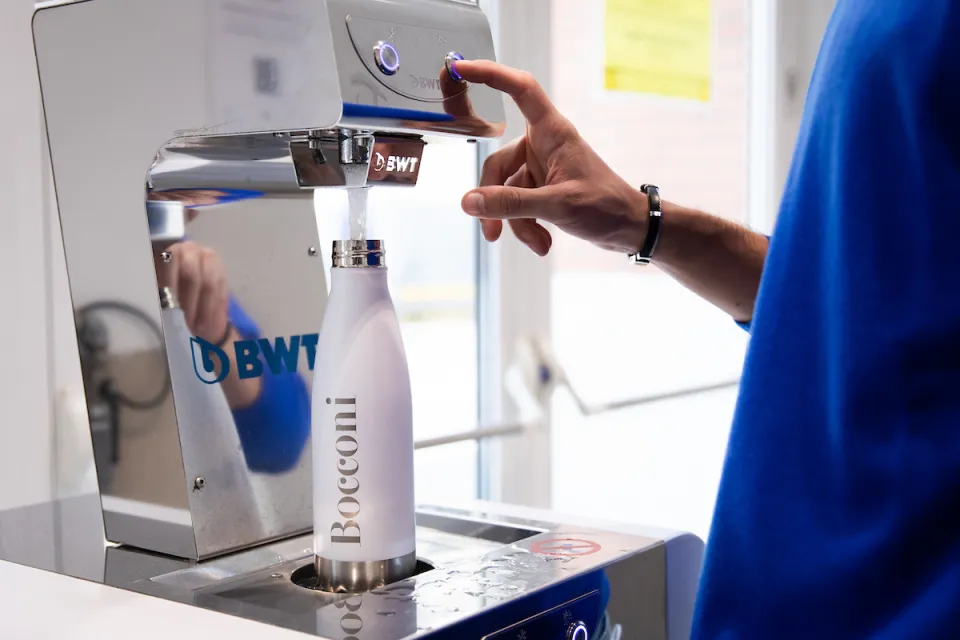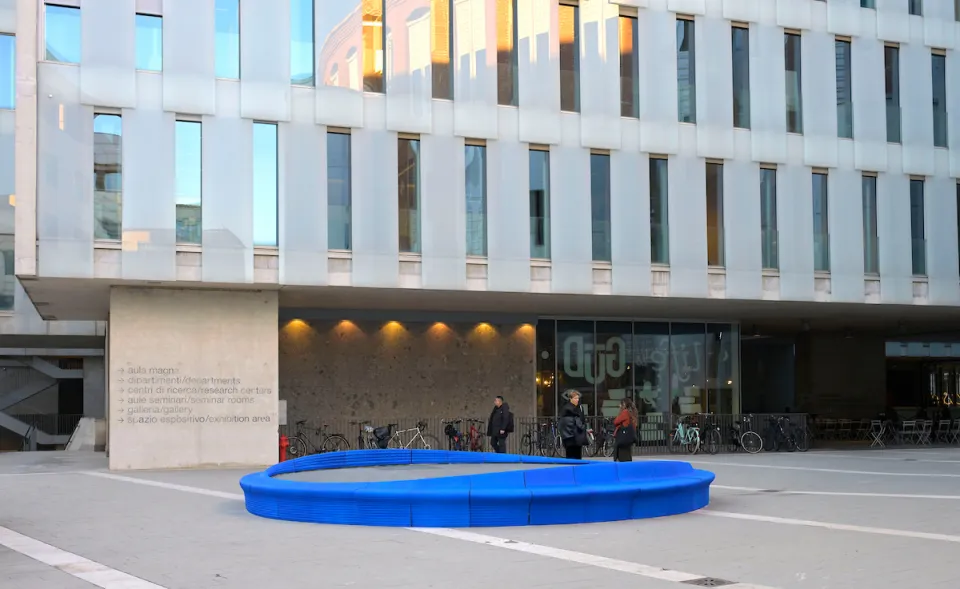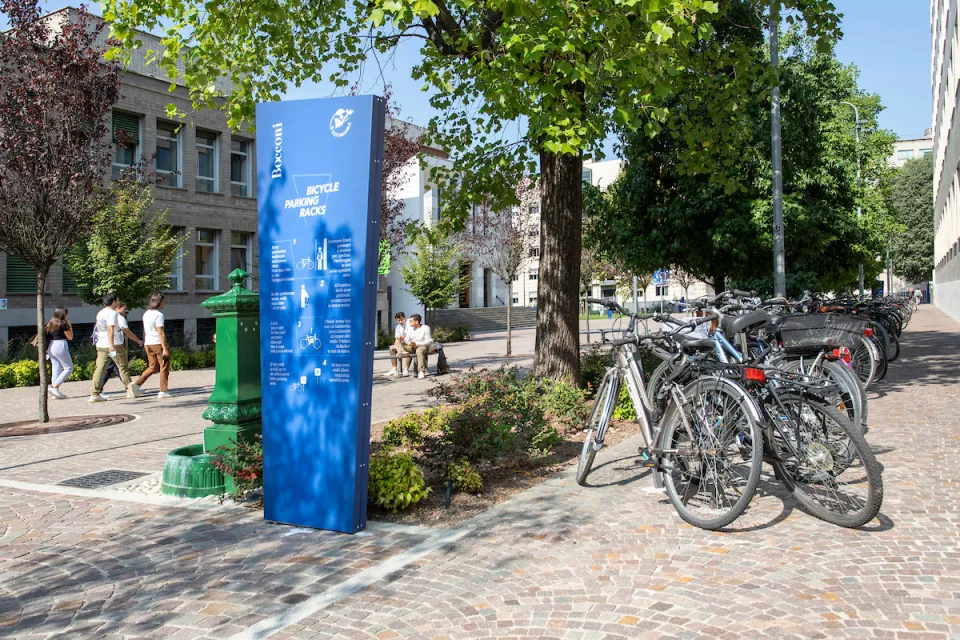Key Environmental Aspects
The University is engaged in a series of initiatives aimed at improving its environmental impact, with particular focus on the areas listed below. These efforts are in line with the macro-objectives defined in the Environmental Policy and form part of a specific line of development set out in the five-year Strategic Plan 2021-2025.
Energy
In recent years, also following the adoption of the ISO 50001-certified energy management system, the University has decided to significantly increase its efforts on this front, working simultaneously towards both energy autonomy and energy efficiency.

Regarding energy autonomy, seizing on the construction of the new "Urban Campus" comprised of Via Sarfatti 10, Via Castelbarco and Viale Toscana, a photovoltaic system with a nominal capacity of approximately 1.2 Megawatts has been operational since 2022, capable of covering approximately 19% of the energy needs of these buildings. With that project, the University has begun to self-generate a portion of the energy needs for its activities, with the aim of gradually increasing this capacity by exploiting the roofing surfaces of other buildings on the campus. Along the same direction, in the 2024-2025 two-year period photovoltaic panels were also installed on the buildings at Via Sarfatti 25, Via Gobbi 5 and the Via Spadolini residence (the latter as part of broader renovation and redevelopment efforts, including energy efficiency improvements). Overall, when these systems are added to those already present on the Urban Campus, the University can currently rely on a photovoltaic array of over 3,400 panels (for a total capacity of 1.35 Megawatts).
The goal of energy efficiency has been pursued primarily in the construction phase of new buildings and/or the renovation of existing ones, through the selection of architectural and structural solutions capable of ensuring higher performance in terms of heat loss reduction and/or energy efficiency optimization. In particular, the following are noteworthy:
- In 2021, the achievement of the LEED Platinum Certification for the building complex at Via Sarfatti 10 (the so-called MEO), the highest level of recognition provided by this international certification standard. This certification, in pursuing a construction approach aimed at sustainability throughout the buildings' life cycle, places particular emphasis on achieving and maintaining high energy performance (facilitated, in this specific case, by the choice of latest-generation building materials and innovative energy systems adopted). In addition to energy, the LEED model also takes into account and monitors water management efficiency (see the "Water" section), the use of materials and resources, indoor air quality, etc.
- Thermal insulation projects carried out in the 2023-2024 two-year period for the Via Spadolini residence (through installation of insulation on all external surfaces, the replacement of existing windows and doors with higher-performance units, the installation and/or enhancement of insulation on the floors and ceilings in certain areas of the building).
In parallel, other energy efficiency projects have been developed in recent years, including a large-scale project involving the progressive replacement of fluorescent lighting sources (bulbs, neon lights) with high-performance LED devices in several buildings on campus. This project has so far involved the Via Roentgen 1, Via Sarfatti 25, Piazza Sraffa 13 and Via Gobbi 5 buildings, resulting in the replacement of over 5,000 lighting fixtures, with estimated annual energy savings of over 560,000kWh.
The University has initiated a plan to gradually remove traditional gas boilers from all campus buildings and student residences and replace them with high-efficiency heat pump systems for the heating and cooling of indoor environments. In August 2024, the heating systems in the buildings at Via Sarfatti 25 and Via Gobbi 5 were decommissioned. This project has resulted in a 20% reduction in natural gas consumption compared to 2023 (see the "Environmental Performance Indicators" section). The other replacements scheduled for 2025 will enable bringing gas consumption down to zero.
Since 2017, the University has decided to exclusively focus on renewable sources with Guarantee of Origin for its electrical energy procurements (in addition to the energy self-generated from its photovoltaic park).
Water, Air and Soil
As part of its Environmental Policy, the University continues to promote initiatives that support water conservation, gradually reduce CO₂ emissions, and ensure the proper maintenance and care of its green spaces.

Following an experiment conducted in 2018, the University has decided to install water dispensers in all campus buildings (near break rooms or other common areas) to ensure users have a free supply of drinking water (either chilled or at room temperature). The initiative was accompanied by the distribution of reusable water bottles to the entire academic community (students, faculty and staff).
Among the measures introduced to promote water conservation, notable was the installation of specific taps equipped with water flow reduction systems (such as flow reducers) in several campus buildings. This solution, used extensively across all water services in the three MEO buildings at Via Sarfatti 10, has resulted in proven savings of 42% of water consumption (data from the 2021 LEED certification report).
Over the past few years, the University has acted on several fronts to mitigate the impact of its activities on air quality and air pollution.
The following are the main interventions completed or underway:
-
The decision, taken in 2017, to source exclusively electricity from renewable sources with a guarantee of origin (in addition to energy self-produced by the photovoltaic park), ensuring significant annual cuts in terms of greenhouse gas emissions (equal to 4,742 TCO2e in 2023 — data calculated using the market-based approach);
-
Plan for the gradual replacement of all gas-fired heating systems in campus buildings and student residences with next-generation heat pump systems, which will ultimately eliminate almost all direct CO2 emissions deriving from combustion.
- Starting in 2020, adoption of a smoke-free policy both inside and outside campus buildings, to promote a healthy and safe environment. In particular, isolated areas designated for smokers have been identified in limited outdoor areas, where special "smoker points" have been set up and appropriately marked, allowing for the collection and subsequent recycling of cigarette butts. This is a circular economy initiative promoted in collaboration with a startup that recovers and transforms cigarette butts into reusable plastic materials.
In addition to complementing the various initiatives mentioned here, the University has begun to systematically measure the greenhouse gas emissions caused by its direct and indirect activities (upstream and downstream value chains). Since 2023, it has drafted a GHG inventory (subject to annual verification based on the ISO 14064-1 international standard).
Measuring the organization’s carbon footprint was the first step Bocconi decided to take to increase awareness of the impact that its direct and indirect activities have on the climate and air quality. This will serve as a starting point for defining emissions reduction targets and plans (to be monitored through annual GHG reporting ).
In recent years, the University has also consistently dedicated efforts to maintaining and taking care of its green and outdoor spaces.
Waste
Over the years, the University has taken several steps to improve the management of urban waste and reduce its production. It has also strengthened the management of special waste (e.g., toner cartridges, WEEE, light bulbs) by introducing specific procedures to ensure proper collection and disposal.

Urban Waste
Beginning in 2023, the Sustainability and Waste Recycling Project was launched to improve waste management, involving several logistical and organizational interventions.
In summary, new recycling points (136 at the end of 2024) have been set up in various University buildings and some external areas, creating waste hubs that are easily identifiable and standardized in terms of size, color and module composition. With the aid of new graphic solutions, the aim was to make the proper waste separation clear and understandable for the entire university community (including the international community, thanks to the use of bilingual labels).
To continuously improve the quality of waste collection, the University uses various waste monitoring tools, including:
- sample analyses of all types of waste produced with the support of the AMSA municipal waste company;
- an artificial intelligence-based system for identifying and directing waste disposal, introduced in 2024 and implemented in a growing number of recycling points (18 out of 136 at the end of 2024).
The information gleaned from these tools allows for accurate waste monitoring, identifying the main issues related to waste disposal and recycling, and the implementation of ad hoc corrective measures.
The improvement of waste sorting processes has resulted in savings of 7.5 TCO2e for 2024 (estimate based on data collected from a sample of monitored containers compared to the total number of recycling points on campus).
In order to pursue the goal — set out in the University Strategic Plan 2021-2025 — of significantly reducing plastic consumption on campus, the University has continued to implement actions initiated in previous years. Specifically, in addition to installing drinking water dispensers and distributing reusable water bottles to the entire academic community, the sale of plastic bottles from vending machines has been progressively eliminated. Suppliers and managers of the canteens and cafeterias located across campus were involved in plastic reduction initiatives and encouraged to review their procurement systems, preferring, where possible, alternatives to single-use plastics (e.g. bioplastics, Tetra Pak containers, reusable cutlery and cups).
The University has adopted various measures to reduce paper use, part of a broader project to digitalize teaching processes (lessons, exams, graduation) developed over the years. This has led, among other things, to the elimination of paper-based theses (starting in 2022), the digital signing of exam transcripts and the full digitization of the faculty register. All these initiatives have led to a steady reduction of printing needs and a drop in the consumption of paper and ancillary materials (such as discarded toner cartridges).
Another measure currently being evaluated, which would further significantly reduce paper and toner consumption, is that of eliminating individual desktop printers and replacing them with a limited number of multifunctional devices (printers, scanners, photocopiers) shared across multiple offices.
Special Waste
In addition to common urban waste, University activities may also produce other types of waste defined as "special waste." The most common categories of special waste found at the University include:
- used printing toner cartridges
- photocopier drum units
- CFL light bulbs and neon tubes
- electrical and electronic end-of-life waste (RAEE), e.g. laptops, PC monitors, printers, headphones
- alkaline batteries
Anyone who produces or finds these types of special waste (with the exception of alkaline batteries, for which specific containers are provided at reception desks of all main buildings on campus) is required to complete a request for disposal via a dedicated platform, specifying the type of waste that needs to be disposed of.
This activates a management and disposal procedure handled by the head of Campus Waste Management, who is responsible for identifying, classifying and placing special waste in special temporary storage facilities, as well as managing relationships with the company responsible for their disposal and keeping track of the necessary documentation (required by law).
As an additional service offered to the Bocconi community (and also extended to neighborhood residents), an agreement has been reached with AMSA to have a Mobile Waste Collection Center (CAM) present in the Piazza Sraffa area on certain days throughout the year. This provides an opportunity to dispose of special waste independently produced (and in any case unrelated to university activities).
Mobility
The University is engaged in several projects aimed at facilitating and, where possible, optimizing mobility to and from the campus, as well as within the surrounding urban area.
Since 2022, most initiatives related to this topic have been framed within the Home-to-Work Commute Plan (PSCL). Its goal is to improve mobility conditions along home-campus routes in collaboration with the Area Mobility Manager. The plan identifies the most suitable methods and actions based on an analysis of the travel behaviors of key users (students, faculty and staff). The expected outcome — within the limits of a complex urban context — is to help reduce city traffic congestion and its associated environmental impact.
For more information, please see a summary of the current Home-to-Work Commute Plan.

In recent years, the area surrounding the university campus has undergone several interventions aimed at improving pedestrian usability, including through a redevelopment of public spaces. These include:
- The delimitation and pedestrianization of the Via Röntgen area completed in 2023 through the installation of cast iron barriers along the perimeter of the intersection between Viale Bligny and Via Röntgen. The aim is to enhance this space, making it not only a thoroughfare but also a meeting place.
- The inauguration of the suburban train (Line S9) Milano Tibaldi-Bocconi University Station in 2022, which made it possible to improve accessibility to the campus through public transport.
- Following an agreement with the Municipality of Milan, the construction of a new pedestrian crossing on Via Sarfatti in 2023, to improve the safety of travel between the two main areas of the university campus.
- The installation (currently underway) of 2 double-connected columns for charging electric vehicles in each garage, also accessible to the public. Garages are located on Via Bocconi, Via Röntgen and Via Castiglioni, for a total of 12 charging points.
The university also ensures the ongoing upkeep and order of the areas around the campus, daily monitoring the correct placement of bicycles, scooters and e-scooters, to prevent them from being left on sidewalks or locked to inappropriate fixtures. It also works in coordination with the relevant parties (Municipality, sharing service managers, etc.) to ensure that they, too, carry out targeted actions.
In this framework, following an agreement with the Municipality of Milan, the University has also sponsored the redevelopment and subsequent maintenance of the flowerbeds along Via Sarfatti and Via Bocconi, which were previously in a state of neglect and were used for illegal car parking.
To promote bicycle mobility, the following interventions have been carried out:
- In 2022, new areas were set up for the safe parking of bicycles used for home-campus travel, which include 110 new stalls in addition to the almost 400 already made available by the University (for more data, see the "Environmental Performance" section).
- There has been a Repair Station near the "Leonardo Del Vecchio" building (Velodromo) since 2020. It is equipped with tools available to the community to carry out small repairs or simple maintenance work on bicycles, such as inflating tires or adjusting the main components.
- Since October 2024, changing rooms have been set up at the Via Bocconi 12 building that can be used by staff members who bike or walk to the University.
Over the years, the University has entered into several agreements to encourage its community to use sustainable mobility as much as possible. In particular, the following are currently active:
- An agreement with a bike sharing company that allows students, faculty and staff to use a certain number of electric bicycles at discounted rates, available at special charging stations located at the Viale Isonzo 21/23, Via Spadolini 12 and Via Buzzi 7 residences, as well as in the pedestrian area between the Via Röntgen and "Leonardo Del Vecchio" (Velodromo) buildings. The agreement includes various formulas: from retail rental to daily, weekly or monthly options, in order to meet the different needs of the University's users, including travel off campus.
- An agreement with a mobility company that offers the entire Bocconi community access to discounted rates for the use of urban and suburban transport services, including public transport, trains, ferries, bicycles, e-scooters, scooters, etc. Through a dedicated application made available by this partner, users can view all the options available in their vicinity on the map and book them directly.
- A partnership with a company that provides access to a series of agreements with some of the leading businesses providing mobility sharing services. This dedicated platform is available to the whole community.
- Agreement with the Milan municipal transport company for the application of discounted rates for transport services to all University employees.
- Agreement with Trenitalia to offer the Bocconi community a discount valid for the purchase of certain types of train tickets for private travel.
In order to guarantee all people equal access and usability of the campus spaces, the following initiatives have been launched:
- Activation of a service accompanying people with reduced mobility on campus (available upon reservation, with the option of weekly scheduling).
- Installation of a video surveillance system and SOS stations within Parco Ravizza and activation of a service accompanying women crossing the Park during the evening and nighttime hours.
The creation of tactile paths within the Campus is also planned, designed to assist blind and visually impaired individuals in navigating between buildings and ensuring full accessibility of all spaces.
There is a specific focus on encouraging University personnel to adopt alternatives to air and private transport for business travel, with an explicit preference for public transport and trains, in line with the objectives of reducing CO2 emissions (see "Environmental Performance" section). In particular, starting in 2024 there has been a mandatory use of trains for business travel between Milan and Rome.